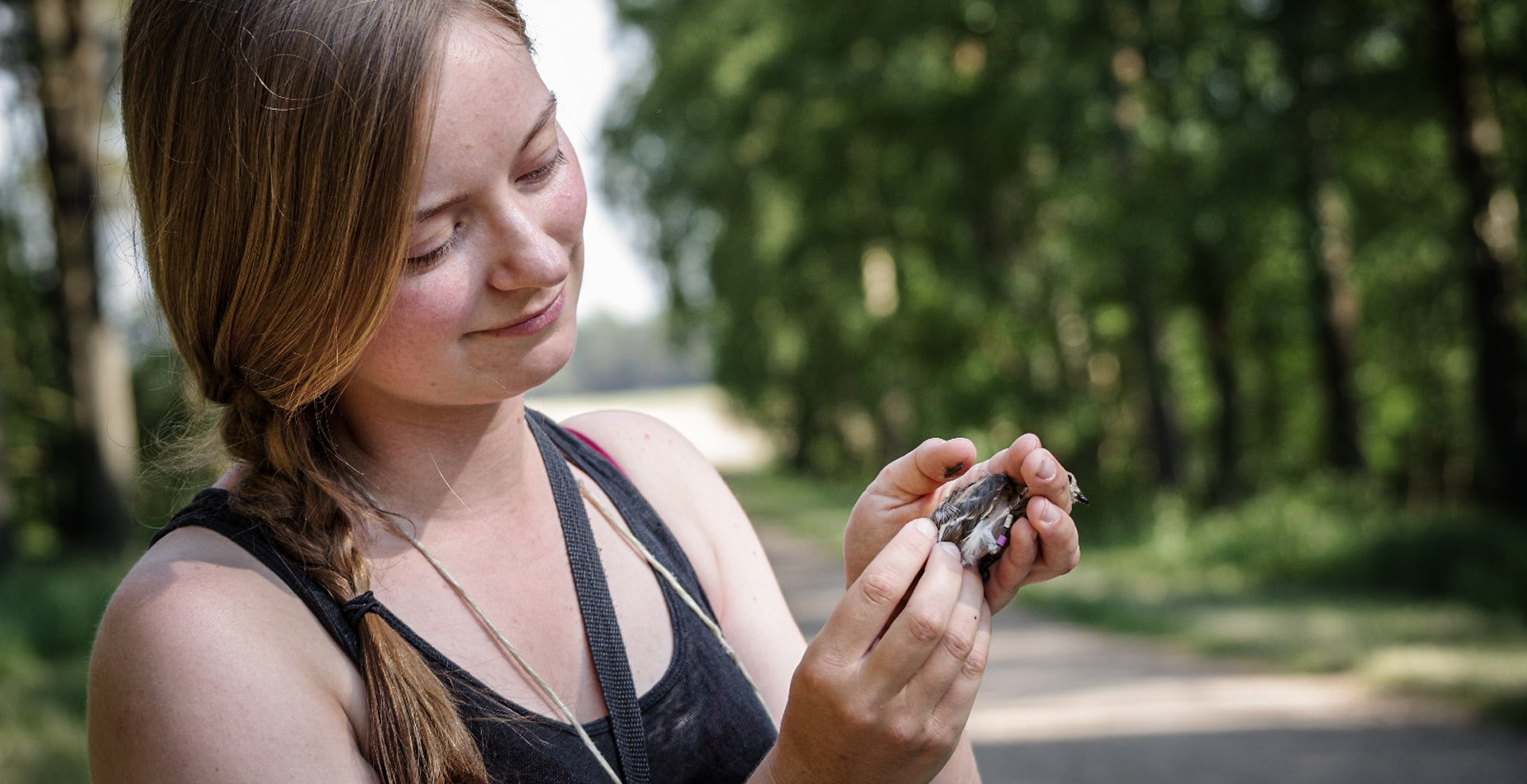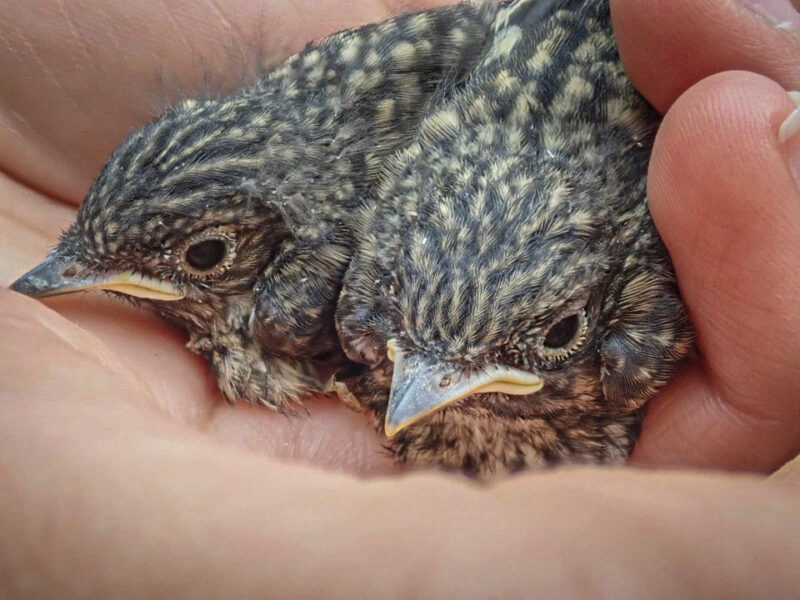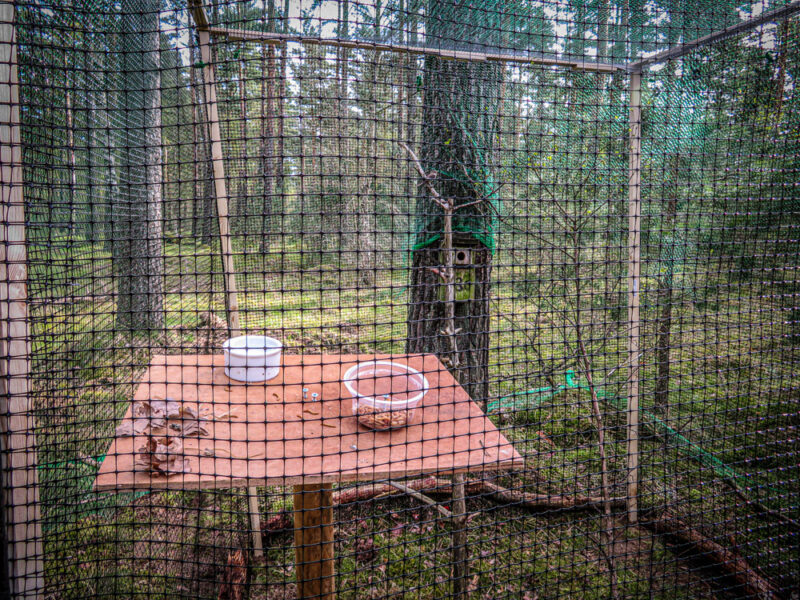
Chasing after spring: Pied flycatchers have become climate refugees
With spring starting earlier each year, migratory birds like the pied flycatcher miss the window where they can eat caterpillars in the Netherlands. Koosje Lamers tried to find out if moving them to a country where spring started later in the year would help them.
A white van hauling mysterious cargo crosses the border into Sweden. It’s not transporting drugs, though, but a dozen light blue eggs and little brown birds. Behind the wheel is PhD student Koosje Lamers, who’s part of the UG’s research institute Conservation Ecology. The birds in the back are on a luxury trip: they usually have to fly halfway around the world themselves, but this time, moving service Koosje is taking them on a trip. She even packed their moving boxes and will decorate their new home.
The brown birds in the back of the van are European pied flycatchers; migratory birds who have been severely impacted by climate change. ‘Over the past few years, the number of migratory birds has steeply declined’, says Lamers.
Over the past few decades, the number of Dutch pied flycatchers has decreased by 90 percent, according to ecologist Christiaan Both and his colleagues who published their findings in Nature magazine in 2006. It’s because spring keeps coming earlier each year. This seasonal shift is caused by climate change.
Miss out
Lamers is trying to figure out if moving migratory birds will help them adapt to the new situation. ‘We want to know what individual birds can do in order to succeed in this ever-changing world’, she says.
Over the past few years, the number of migratory birds has steeply declined
Because temperatures rise earlier in the year, the flycatchers’ young miss out on their meal. In spite of their name, their diet mainly consists of caterpillars. Every year, pied flycatchers look forward to a period where the number of caterpillars is at its high so they can eat their fill. But the past few years, the birds have simply arrived at the table too late. The pied flycatcher’s favourite treat keeps pupating earlier and fling away.
Because pied flycatchers spend the winter on the other side of the Sahara, it’s difficult for them to get back in time for the peak in caterpillar population. ‘Great tits, who winter in the Netherlands, can tell from the environment that spring has started, even if it’s early’, says Lamers. They can adjust and start making their nest. But all the way over in Africa, pied flycatchers have no idea.

DNA
Pied flycatchers keep a strict schedule; every moment, from the time they leave Africa to when they start laying eggs, is carefully planned. This planning is encoded in their DNA, which makes it difficult to change. ‘Migratory birds should really be changing their genes to ensure they’re in time for the earlier caterpillar peak’, says Lamers. But it’s not that simple.
Lamers wondered what would happen if they moved to a place where spring didn’t start until later. This led to the idea to move Dutch pied flycatchers to Sweden, where the trees blossom two weeks later and the caterpillars don’t pupate until then.
Great tits can tell from the environment that spring has started, migratory birds can’t
Moving birds isn’t all it’s cracked up to be, she’s realised. Once she arrived in the Vombs Fure forest in the south of Sweden, approximately forty kilometres from Malmö, it took her quite a while to locate the dark green nesting boxes which were spread out over the woods. It took up a lot of time in the first few years of her study, but these days, Lamers knows the forest like the back of her hand. She and her colleagues also had to construct an aviary around every single nesting box, to prevent the females from immediately returning to the Netherlands.
More chicks
Lamers compared Dutch pied flycatchers to their Swedish counterparts and realised that the birds’ sense of time is encoded in their genes and that it differs depending on which country they’re from. The Dutch birds she studied started brooding first, the Swedish started brooding last, and half-Dutch birds, with a Dutch mother and a Swedish father, brooded exactly in the middle.

The Dutch pied flycatchers thrived in the south of Sweden. ‘The year after hatching, Dutch females in Sweden produce more chicks that return to the breeding grounds than the Swedish birds’, says Lamers. Timing plays an important part in this, it seems; the Dutch chicks, which have hatched earlier, have a great chance of returning to the area as adults the following year.
According to Lamers, the results are positive, because it means the birds can relatively easily adjust to the change in climate. ‘The genes that are necessary to thrive in the south of Sweden are present in the Dutch pied flycatchers.’ That means they can relocate, even if the climate changes even more.
Natural order
The birds don’t just get moved in a white van for Lamers’ research; they also move on their own. ‘Critics tend to think that we disrupt the natural order of things by moving the birds’, she says. But individual birds are constantly moving in the wild. It’s not that different from when people move, says Lamers. ‘I grew up in Zeeland, but I now live in Groningen.’ The same applies to birds. ‘A German amateur birder once saw pied flycatchers from Drenthe in his garden. They were half-way on the way to Sweden.’
We want to know what animals can do by themselves in the face of climate change
While moving birds is already a conservation policy, it’s not the goal of her research. ‘We want to know what animals can do by themselves in the face of climate change. Our moving of the pied flycatchers has been approved by various animal testing committees’, she says, which means amateurs should not start moving birds around.
Winter
The last part of Lamers’ research will focus on where in Africa the pied flycatchers spend the winter, and when exactly they leave to return up north. Could the wintering location and time of departure be encoded in their genes as well? She’s currently analysing the data she has gathered.
At the same time, she’s putting the finishing touches on the academic article she wrote together with colleagues at Lund University. It has just been published in Nature Ecology & Evolution, an academic journal.
But she would have preferred to spend this year in Sweden. ‘This is the first time in a few years that I’m not in Sweden for the spring.’ Wandering the forest, checking nesting boxes, and working with a team of students are what makes her love her research so much, she says. ‘Spring is my favourite season and I love spending it in the woods. That’s where I feel truly at home.’